Salbutamol Use and Asthma Outcomes
VerifiedAdded on 2020/04/07
|13
|3533
|60
AI Summary
This assignment delves into the relationship between salbutamol use and adverse outcomes in asthma patients. Students will critically evaluate a set of research articles examining metrics of salbutamol usage as predictors of future health complications related to asthma. The analysis should encompass the potential risks and benefits of this widely used asthma treatment.
Contribute Materials
Your contribution can guide someone’s learning journey. Share your
documents today.
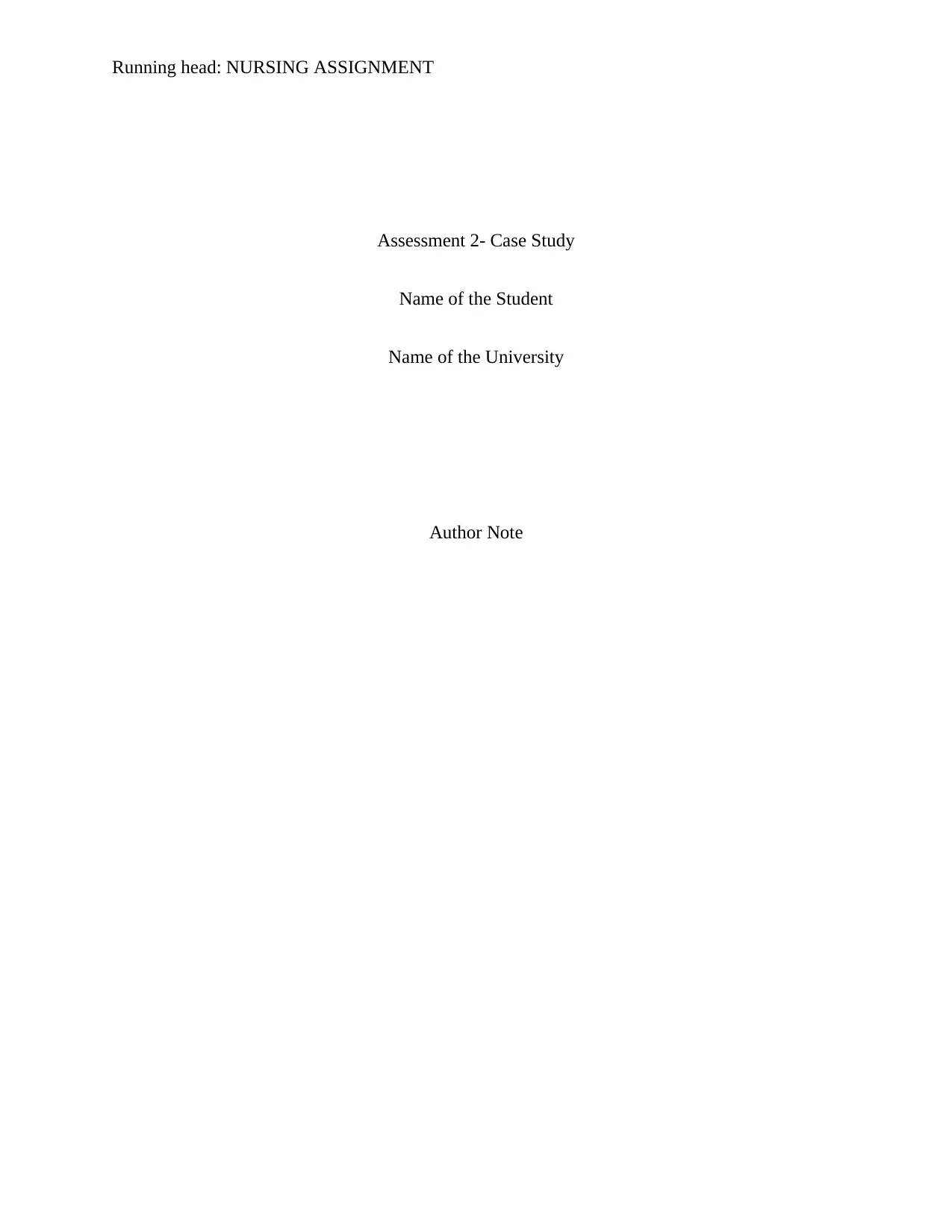
Running head: NURSING ASSIGNMENT
Assessment 2- Case Study
Name of the Student
Name of the University
Author Note
Assessment 2- Case Study
Name of the Student
Name of the University
Author Note
Secure Best Marks with AI Grader
Need help grading? Try our AI Grader for instant feedback on your assignments.
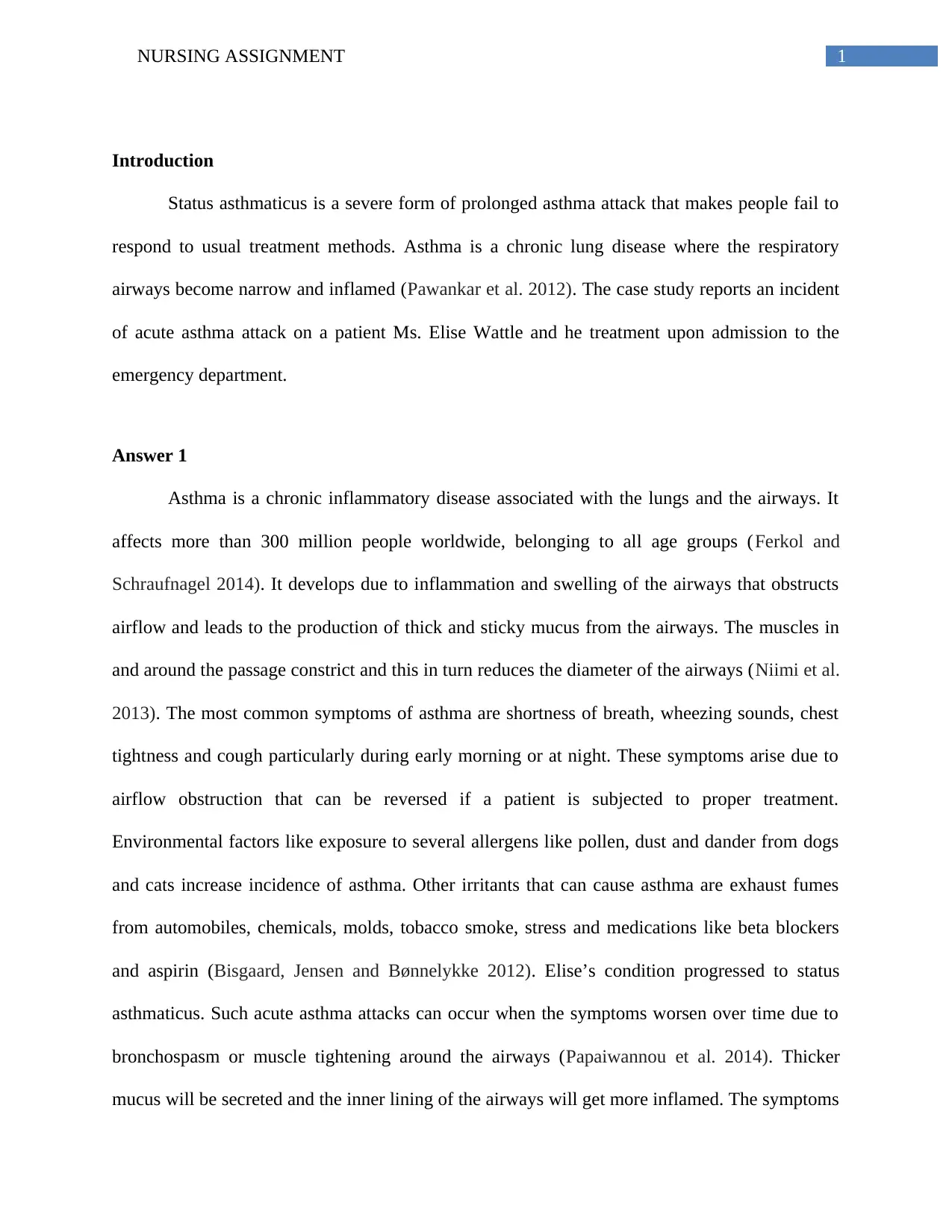
1NURSING ASSIGNMENT
Introduction
Status asthmaticus is a severe form of prolonged asthma attack that makes people fail to
respond to usual treatment methods. Asthma is a chronic lung disease where the respiratory
airways become narrow and inflamed (Pawankar et al. 2012). The case study reports an incident
of acute asthma attack on a patient Ms. Elise Wattle and he treatment upon admission to the
emergency department.
Answer 1
Asthma is a chronic inflammatory disease associated with the lungs and the airways. It
affects more than 300 million people worldwide, belonging to all age groups (Ferkol and
Schraufnagel 2014). It develops due to inflammation and swelling of the airways that obstructs
airflow and leads to the production of thick and sticky mucus from the airways. The muscles in
and around the passage constrict and this in turn reduces the diameter of the airways (Niimi et al.
2013). The most common symptoms of asthma are shortness of breath, wheezing sounds, chest
tightness and cough particularly during early morning or at night. These symptoms arise due to
airflow obstruction that can be reversed if a patient is subjected to proper treatment.
Environmental factors like exposure to several allergens like pollen, dust and dander from dogs
and cats increase incidence of asthma. Other irritants that can cause asthma are exhaust fumes
from automobiles, chemicals, molds, tobacco smoke, stress and medications like beta blockers
and aspirin (Bisgaard, Jensen and Bønnelykke 2012). Elise’s condition progressed to status
asthmaticus. Such acute asthma attacks can occur when the symptoms worsen over time due to
bronchospasm or muscle tightening around the airways (Papaiwannou et al. 2014). Thicker
mucus will be secreted and the inner lining of the airways will get more inflamed. The symptoms
Introduction
Status asthmaticus is a severe form of prolonged asthma attack that makes people fail to
respond to usual treatment methods. Asthma is a chronic lung disease where the respiratory
airways become narrow and inflamed (Pawankar et al. 2012). The case study reports an incident
of acute asthma attack on a patient Ms. Elise Wattle and he treatment upon admission to the
emergency department.
Answer 1
Asthma is a chronic inflammatory disease associated with the lungs and the airways. It
affects more than 300 million people worldwide, belonging to all age groups (Ferkol and
Schraufnagel 2014). It develops due to inflammation and swelling of the airways that obstructs
airflow and leads to the production of thick and sticky mucus from the airways. The muscles in
and around the passage constrict and this in turn reduces the diameter of the airways (Niimi et al.
2013). The most common symptoms of asthma are shortness of breath, wheezing sounds, chest
tightness and cough particularly during early morning or at night. These symptoms arise due to
airflow obstruction that can be reversed if a patient is subjected to proper treatment.
Environmental factors like exposure to several allergens like pollen, dust and dander from dogs
and cats increase incidence of asthma. Other irritants that can cause asthma are exhaust fumes
from automobiles, chemicals, molds, tobacco smoke, stress and medications like beta blockers
and aspirin (Bisgaard, Jensen and Bønnelykke 2012). Elise’s condition progressed to status
asthmaticus. Such acute asthma attacks can occur when the symptoms worsen over time due to
bronchospasm or muscle tightening around the airways (Papaiwannou et al. 2014). Thicker
mucus will be secreted and the inner lining of the airways will get more inflamed. The symptoms
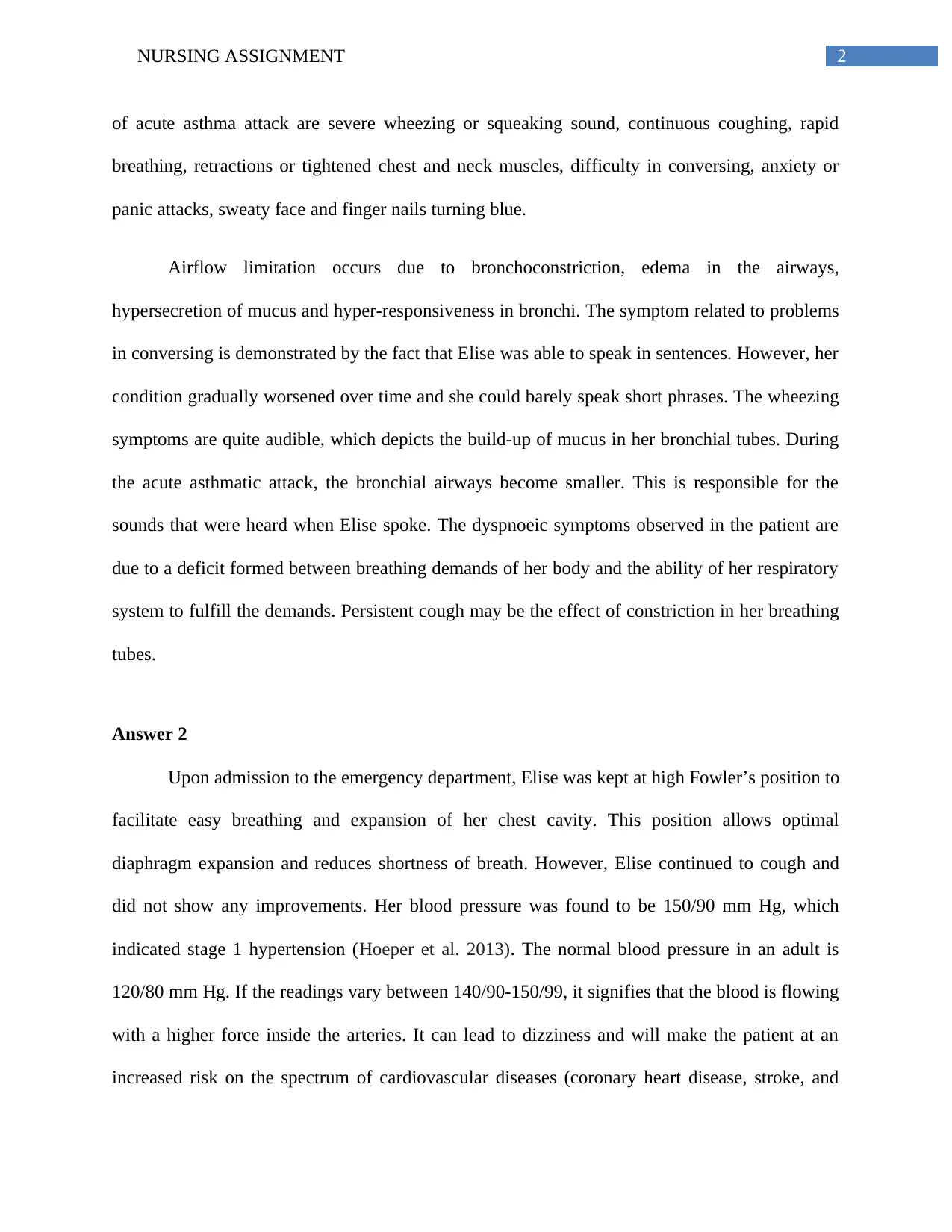
2NURSING ASSIGNMENT
of acute asthma attack are severe wheezing or squeaking sound, continuous coughing, rapid
breathing, retractions or tightened chest and neck muscles, difficulty in conversing, anxiety or
panic attacks, sweaty face and finger nails turning blue.
Airflow limitation occurs due to bronchoconstriction, edema in the airways,
hypersecretion of mucus and hyper-responsiveness in bronchi. The symptom related to problems
in conversing is demonstrated by the fact that Elise was able to speak in sentences. However, her
condition gradually worsened over time and she could barely speak short phrases. The wheezing
symptoms are quite audible, which depicts the build-up of mucus in her bronchial tubes. During
the acute asthmatic attack, the bronchial airways become smaller. This is responsible for the
sounds that were heard when Elise spoke. The dyspnoeic symptoms observed in the patient are
due to a deficit formed between breathing demands of her body and the ability of her respiratory
system to fulfill the demands. Persistent cough may be the effect of constriction in her breathing
tubes.
Answer 2
Upon admission to the emergency department, Elise was kept at high Fowler’s position to
facilitate easy breathing and expansion of her chest cavity. This position allows optimal
diaphragm expansion and reduces shortness of breath. However, Elise continued to cough and
did not show any improvements. Her blood pressure was found to be 150/90 mm Hg, which
indicated stage 1 hypertension (Hoeper et al. 2013). The normal blood pressure in an adult is
120/80 mm Hg. If the readings vary between 140/90-150/99, it signifies that the blood is flowing
with a higher force inside the arteries. It can lead to dizziness and will make the patient at an
increased risk on the spectrum of cardiovascular diseases (coronary heart disease, stroke, and
of acute asthma attack are severe wheezing or squeaking sound, continuous coughing, rapid
breathing, retractions or tightened chest and neck muscles, difficulty in conversing, anxiety or
panic attacks, sweaty face and finger nails turning blue.
Airflow limitation occurs due to bronchoconstriction, edema in the airways,
hypersecretion of mucus and hyper-responsiveness in bronchi. The symptom related to problems
in conversing is demonstrated by the fact that Elise was able to speak in sentences. However, her
condition gradually worsened over time and she could barely speak short phrases. The wheezing
symptoms are quite audible, which depicts the build-up of mucus in her bronchial tubes. During
the acute asthmatic attack, the bronchial airways become smaller. This is responsible for the
sounds that were heard when Elise spoke. The dyspnoeic symptoms observed in the patient are
due to a deficit formed between breathing demands of her body and the ability of her respiratory
system to fulfill the demands. Persistent cough may be the effect of constriction in her breathing
tubes.
Answer 2
Upon admission to the emergency department, Elise was kept at high Fowler’s position to
facilitate easy breathing and expansion of her chest cavity. This position allows optimal
diaphragm expansion and reduces shortness of breath. However, Elise continued to cough and
did not show any improvements. Her blood pressure was found to be 150/90 mm Hg, which
indicated stage 1 hypertension (Hoeper et al. 2013). The normal blood pressure in an adult is
120/80 mm Hg. If the readings vary between 140/90-150/99, it signifies that the blood is flowing
with a higher force inside the arteries. It can lead to dizziness and will make the patient at an
increased risk on the spectrum of cardiovascular diseases (coronary heart disease, stroke, and

3NURSING ASSIGNMENT
congestive heart failure), renal failure and vision impairment (Busse et al. 2012). Her pulse was
found to be 126 bpm. This pulse rate is considered higher than the normal levels of 60-100 in an
adult. Such elevated pulse rates are referred to as tachycardia. It occurs when the heart pumps
blood at a faster rate that leads to inefficient circulation of blood to the body parts. When Elise
experienced an acute asthmatic attack, there was deficiency of oxygen in her body cells. Her
breathlessness made it difficult for the blood to receive enough oxygen. Thus, her heart started to
pump rapidly in an effort to meet the oxygen demand and this gave rise to an increased pulse.
Psychological factors may also be responsible for this increased pulse rate. An acute asthmatic
attack often leads to panic and anxiety. That increases the heart rate and thereby elevates the
pulse.
Her respiration was shallow and 30. At rest the normal breathing rate in adults is 8-16 per
minute. Elise exhibited a high respiratory rate, which is generally denoted by the term tachypnea.
Minimal air was drawn into the lungs by the action of intercostal muscles. The asthmatic
condition of the patient is the principal reason for this vital sign. Moreover, shortness of breath
and rapid pulse elevated her respiration rate (Vestbo et al. 2013). Normal human body
temperature is around 37°C and Elise did not show much variation (37.3°C). This is due to the
fact that asthma generally does not lead to chills, fever and muscle ache. Her pulse oximeter
readings were 92%. An oxygen saturation level beyond 95% is considered normal. A reduction
in her oxygen levels suggested oxygen deficiency in her arterial blood, which occurred as a result
of breathing difficulty. Elevated levels of IgE and eosinophils in sputum and blood tests revealed
persistent allergy. Allergens are a major cause of asthma. Her high IgE levels indicated that she
is exposed to more than one allergy. This proves that hypersensitivity to local allergens and
increase in serum IgE are associated with her symptoms of asthmatic attack and wheezing.
congestive heart failure), renal failure and vision impairment (Busse et al. 2012). Her pulse was
found to be 126 bpm. This pulse rate is considered higher than the normal levels of 60-100 in an
adult. Such elevated pulse rates are referred to as tachycardia. It occurs when the heart pumps
blood at a faster rate that leads to inefficient circulation of blood to the body parts. When Elise
experienced an acute asthmatic attack, there was deficiency of oxygen in her body cells. Her
breathlessness made it difficult for the blood to receive enough oxygen. Thus, her heart started to
pump rapidly in an effort to meet the oxygen demand and this gave rise to an increased pulse.
Psychological factors may also be responsible for this increased pulse rate. An acute asthmatic
attack often leads to panic and anxiety. That increases the heart rate and thereby elevates the
pulse.
Her respiration was shallow and 30. At rest the normal breathing rate in adults is 8-16 per
minute. Elise exhibited a high respiratory rate, which is generally denoted by the term tachypnea.
Minimal air was drawn into the lungs by the action of intercostal muscles. The asthmatic
condition of the patient is the principal reason for this vital sign. Moreover, shortness of breath
and rapid pulse elevated her respiration rate (Vestbo et al. 2013). Normal human body
temperature is around 37°C and Elise did not show much variation (37.3°C). This is due to the
fact that asthma generally does not lead to chills, fever and muscle ache. Her pulse oximeter
readings were 92%. An oxygen saturation level beyond 95% is considered normal. A reduction
in her oxygen levels suggested oxygen deficiency in her arterial blood, which occurred as a result
of breathing difficulty. Elevated levels of IgE and eosinophils in sputum and blood tests revealed
persistent allergy. Allergens are a major cause of asthma. Her high IgE levels indicated that she
is exposed to more than one allergy. This proves that hypersensitivity to local allergens and
increase in serum IgE are associated with her symptoms of asthmatic attack and wheezing.
Secure Best Marks with AI Grader
Need help grading? Try our AI Grader for instant feedback on your assignments.

4NURSING ASSIGNMENT
Several research studies show that an increase in the number of eosinophils, correlate with
severity of asthmatic attacks (Korevaar et al. 2015). Eosinophils and neutrophils lead to cellular
inflammation of the bronchi passages. When these white blood cells reach the airways, they
release chemical contents that cause airway inflammation and blockage of the nasal passage and
sinuses.
Thus, the increased level of eosinophil in the patient triggered exposure to asthmatic
symptoms. Her ABG results showed a pH of 7.49, which is more than the normal range of 7.35-
7.45. Her pCO2 is 22 mg Hg (< normal range of 35-45 mm Hg). This suggests likely presence of
alkalosis or alkalemia condition in her body due to probable reduction of concentration of
hydrogen ions. Her condition suggests respiratory alkalosis that might have occurred due to
hyperventilation and may lead to a loss of carbon dioxide. Moreover, the pO2 levels are found to
be 74 mm Hg (< normal range of 80-100 mm Hg). This low pO2 level suggests that the lungs are
not effective in pulling oxygen gas into the blood stream. This occurred due to her asthmatic
attacks that are a form of chronic pulmonary disease. Her HCO3 levels were 22 mEq/L, which
shows compliance with the normal range of 22-26 m Eq/L. This does not provide any evidence
for the presence of primary metabolic disorders in her system.
Answer 3
Normal blood sugar levels range between 4.0-6.0 mmol/L during fasting and upto 7.8
mmol/L, 2 hours post eating. Elise’s serum glucose levels were 5.0mmol/L, within the normal
range that suggests she is non-diabetic. Her blood urea nitrogen levels are 6.2 mmol/L that falls
in the normal range of 2.5-7.1 mol/L. Normal serum creatinine levels for women are 45-90
μmol/L. Her creatinine levels fall in this range. Thus, it can be deciphered that her liver and
Several research studies show that an increase in the number of eosinophils, correlate with
severity of asthmatic attacks (Korevaar et al. 2015). Eosinophils and neutrophils lead to cellular
inflammation of the bronchi passages. When these white blood cells reach the airways, they
release chemical contents that cause airway inflammation and blockage of the nasal passage and
sinuses.
Thus, the increased level of eosinophil in the patient triggered exposure to asthmatic
symptoms. Her ABG results showed a pH of 7.49, which is more than the normal range of 7.35-
7.45. Her pCO2 is 22 mg Hg (< normal range of 35-45 mm Hg). This suggests likely presence of
alkalosis or alkalemia condition in her body due to probable reduction of concentration of
hydrogen ions. Her condition suggests respiratory alkalosis that might have occurred due to
hyperventilation and may lead to a loss of carbon dioxide. Moreover, the pO2 levels are found to
be 74 mm Hg (< normal range of 80-100 mm Hg). This low pO2 level suggests that the lungs are
not effective in pulling oxygen gas into the blood stream. This occurred due to her asthmatic
attacks that are a form of chronic pulmonary disease. Her HCO3 levels were 22 mEq/L, which
shows compliance with the normal range of 22-26 m Eq/L. This does not provide any evidence
for the presence of primary metabolic disorders in her system.
Answer 3
Normal blood sugar levels range between 4.0-6.0 mmol/L during fasting and upto 7.8
mmol/L, 2 hours post eating. Elise’s serum glucose levels were 5.0mmol/L, within the normal
range that suggests she is non-diabetic. Her blood urea nitrogen levels are 6.2 mmol/L that falls
in the normal range of 2.5-7.1 mol/L. Normal serum creatinine levels for women are 45-90
μmol/L. Her creatinine levels fall in this range. Thus, it can be deciphered that her liver and
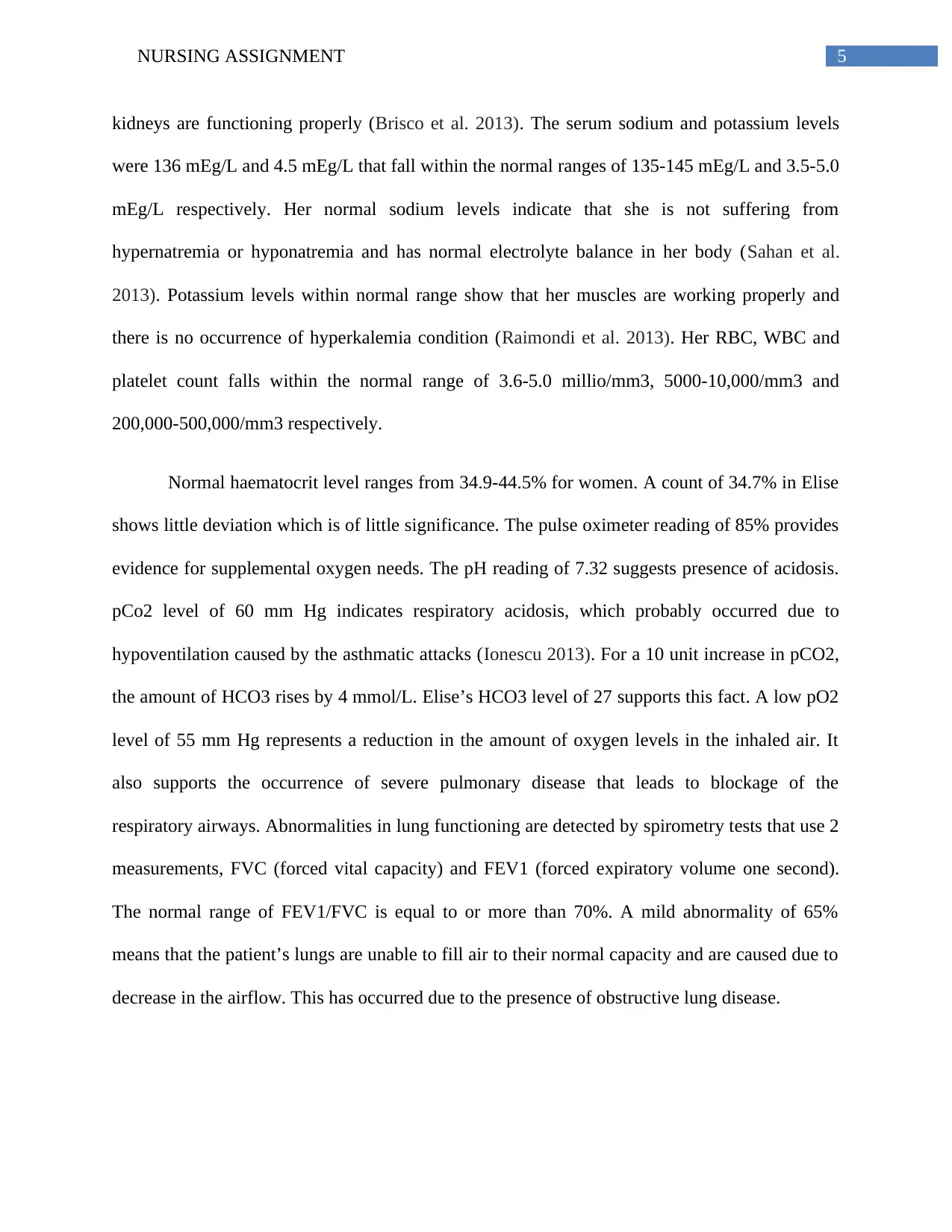
5NURSING ASSIGNMENT
kidneys are functioning properly (Brisco et al. 2013). The serum sodium and potassium levels
were 136 mEg/L and 4.5 mEg/L that fall within the normal ranges of 135-145 mEg/L and 3.5-5.0
mEg/L respectively. Her normal sodium levels indicate that she is not suffering from
hypernatremia or hyponatremia and has normal electrolyte balance in her body (Sahan et al.
2013). Potassium levels within normal range show that her muscles are working properly and
there is no occurrence of hyperkalemia condition (Raimondi et al. 2013). Her RBC, WBC and
platelet count falls within the normal range of 3.6-5.0 millio/mm3, 5000-10,000/mm3 and
200,000-500,000/mm3 respectively.
Normal haematocrit level ranges from 34.9-44.5% for women. A count of 34.7% in Elise
shows little deviation which is of little significance. The pulse oximeter reading of 85% provides
evidence for supplemental oxygen needs. The pH reading of 7.32 suggests presence of acidosis.
pCo2 level of 60 mm Hg indicates respiratory acidosis, which probably occurred due to
hypoventilation caused by the asthmatic attacks (Ionescu 2013). For a 10 unit increase in pCO2,
the amount of HCO3 rises by 4 mmol/L. Elise’s HCO3 level of 27 supports this fact. A low pO2
level of 55 mm Hg represents a reduction in the amount of oxygen levels in the inhaled air. It
also supports the occurrence of severe pulmonary disease that leads to blockage of the
respiratory airways. Abnormalities in lung functioning are detected by spirometry tests that use 2
measurements, FVC (forced vital capacity) and FEV1 (forced expiratory volume one second).
The normal range of FEV1/FVC is equal to or more than 70%. A mild abnormality of 65%
means that the patient’s lungs are unable to fill air to their normal capacity and are caused due to
decrease in the airflow. This has occurred due to the presence of obstructive lung disease.
kidneys are functioning properly (Brisco et al. 2013). The serum sodium and potassium levels
were 136 mEg/L and 4.5 mEg/L that fall within the normal ranges of 135-145 mEg/L and 3.5-5.0
mEg/L respectively. Her normal sodium levels indicate that she is not suffering from
hypernatremia or hyponatremia and has normal electrolyte balance in her body (Sahan et al.
2013). Potassium levels within normal range show that her muscles are working properly and
there is no occurrence of hyperkalemia condition (Raimondi et al. 2013). Her RBC, WBC and
platelet count falls within the normal range of 3.6-5.0 millio/mm3, 5000-10,000/mm3 and
200,000-500,000/mm3 respectively.
Normal haematocrit level ranges from 34.9-44.5% for women. A count of 34.7% in Elise
shows little deviation which is of little significance. The pulse oximeter reading of 85% provides
evidence for supplemental oxygen needs. The pH reading of 7.32 suggests presence of acidosis.
pCo2 level of 60 mm Hg indicates respiratory acidosis, which probably occurred due to
hypoventilation caused by the asthmatic attacks (Ionescu 2013). For a 10 unit increase in pCO2,
the amount of HCO3 rises by 4 mmol/L. Elise’s HCO3 level of 27 supports this fact. A low pO2
level of 55 mm Hg represents a reduction in the amount of oxygen levels in the inhaled air. It
also supports the occurrence of severe pulmonary disease that leads to blockage of the
respiratory airways. Abnormalities in lung functioning are detected by spirometry tests that use 2
measurements, FVC (forced vital capacity) and FEV1 (forced expiratory volume one second).
The normal range of FEV1/FVC is equal to or more than 70%. A mild abnormality of 65%
means that the patient’s lungs are unable to fill air to their normal capacity and are caused due to
decrease in the airflow. This has occurred due to the presence of obstructive lung disease.
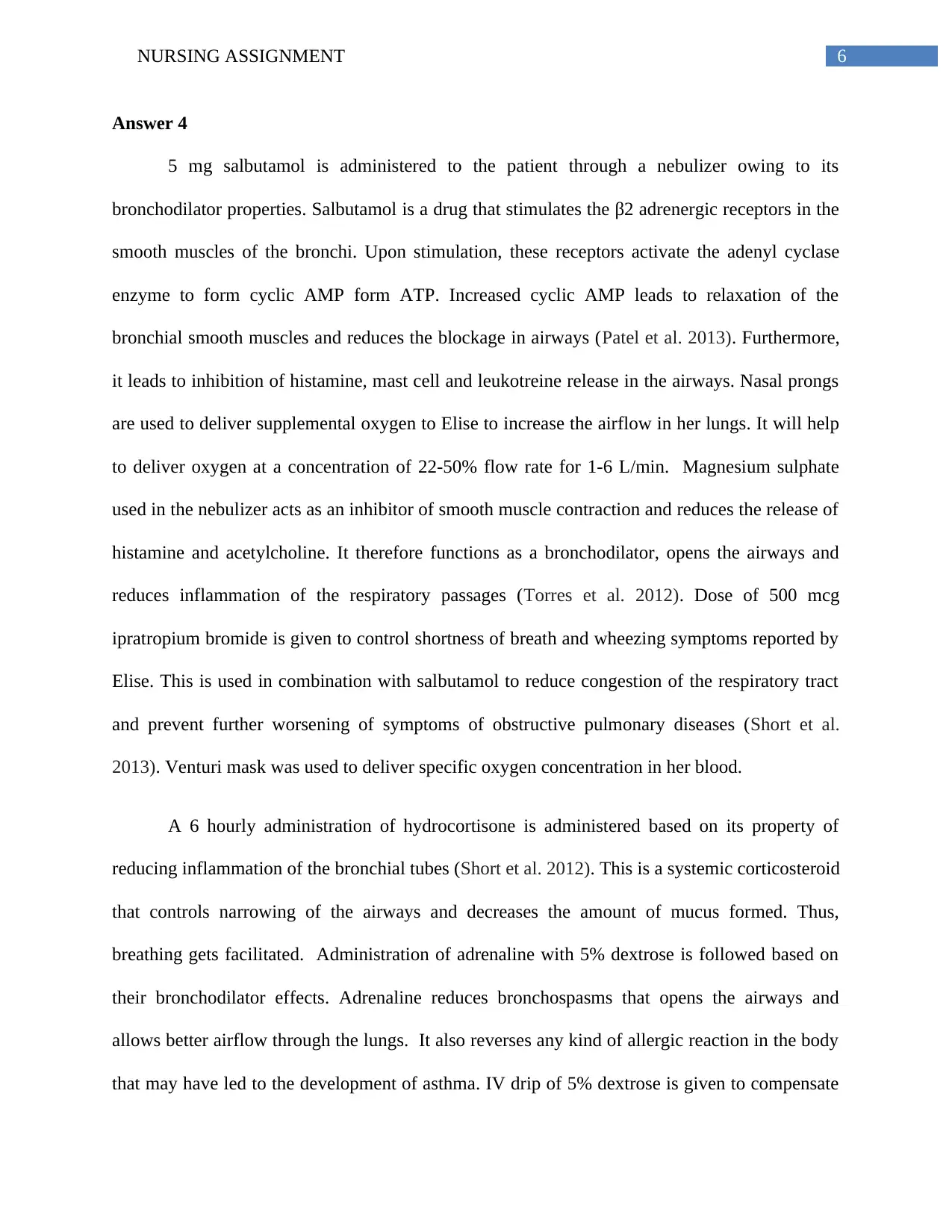
6NURSING ASSIGNMENT
Answer 4
5 mg salbutamol is administered to the patient through a nebulizer owing to its
bronchodilator properties. Salbutamol is a drug that stimulates the β2 adrenergic receptors in the
smooth muscles of the bronchi. Upon stimulation, these receptors activate the adenyl cyclase
enzyme to form cyclic AMP form ATP. Increased cyclic AMP leads to relaxation of the
bronchial smooth muscles and reduces the blockage in airways (Patel et al. 2013). Furthermore,
it leads to inhibition of histamine, mast cell and leukotreine release in the airways. Nasal prongs
are used to deliver supplemental oxygen to Elise to increase the airflow in her lungs. It will help
to deliver oxygen at a concentration of 22-50% flow rate for 1-6 L/min. Magnesium sulphate
used in the nebulizer acts as an inhibitor of smooth muscle contraction and reduces the release of
histamine and acetylcholine. It therefore functions as a bronchodilator, opens the airways and
reduces inflammation of the respiratory passages (Torres et al. 2012). Dose of 500 mcg
ipratropium bromide is given to control shortness of breath and wheezing symptoms reported by
Elise. This is used in combination with salbutamol to reduce congestion of the respiratory tract
and prevent further worsening of symptoms of obstructive pulmonary diseases (Short et al.
2013). Venturi mask was used to deliver specific oxygen concentration in her blood.
A 6 hourly administration of hydrocortisone is administered based on its property of
reducing inflammation of the bronchial tubes (Short et al. 2012). This is a systemic corticosteroid
that controls narrowing of the airways and decreases the amount of mucus formed. Thus,
breathing gets facilitated. Administration of adrenaline with 5% dextrose is followed based on
their bronchodilator effects. Adrenaline reduces bronchospasms that opens the airways and
allows better airflow through the lungs. It also reverses any kind of allergic reaction in the body
that may have led to the development of asthma. IV drip of 5% dextrose is given to compensate
Answer 4
5 mg salbutamol is administered to the patient through a nebulizer owing to its
bronchodilator properties. Salbutamol is a drug that stimulates the β2 adrenergic receptors in the
smooth muscles of the bronchi. Upon stimulation, these receptors activate the adenyl cyclase
enzyme to form cyclic AMP form ATP. Increased cyclic AMP leads to relaxation of the
bronchial smooth muscles and reduces the blockage in airways (Patel et al. 2013). Furthermore,
it leads to inhibition of histamine, mast cell and leukotreine release in the airways. Nasal prongs
are used to deliver supplemental oxygen to Elise to increase the airflow in her lungs. It will help
to deliver oxygen at a concentration of 22-50% flow rate for 1-6 L/min. Magnesium sulphate
used in the nebulizer acts as an inhibitor of smooth muscle contraction and reduces the release of
histamine and acetylcholine. It therefore functions as a bronchodilator, opens the airways and
reduces inflammation of the respiratory passages (Torres et al. 2012). Dose of 500 mcg
ipratropium bromide is given to control shortness of breath and wheezing symptoms reported by
Elise. This is used in combination with salbutamol to reduce congestion of the respiratory tract
and prevent further worsening of symptoms of obstructive pulmonary diseases (Short et al.
2013). Venturi mask was used to deliver specific oxygen concentration in her blood.
A 6 hourly administration of hydrocortisone is administered based on its property of
reducing inflammation of the bronchial tubes (Short et al. 2012). This is a systemic corticosteroid
that controls narrowing of the airways and decreases the amount of mucus formed. Thus,
breathing gets facilitated. Administration of adrenaline with 5% dextrose is followed based on
their bronchodilator effects. Adrenaline reduces bronchospasms that opens the airways and
allows better airflow through the lungs. It also reverses any kind of allergic reaction in the body
that may have led to the development of asthma. IV drip of 5% dextrose is given to compensate
Paraphrase This Document
Need a fresh take? Get an instant paraphrase of this document with our AI Paraphraser
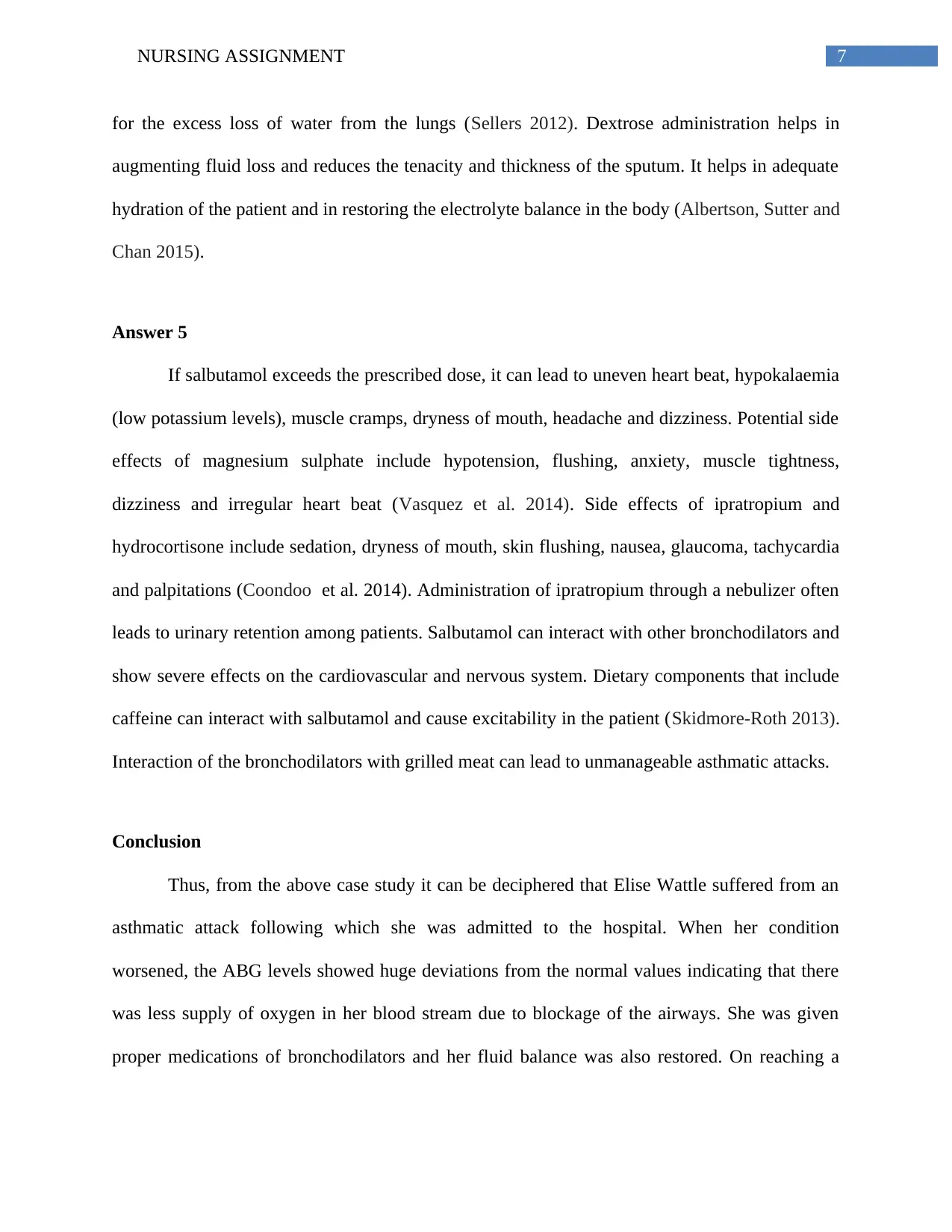
7NURSING ASSIGNMENT
for the excess loss of water from the lungs (Sellers 2012). Dextrose administration helps in
augmenting fluid loss and reduces the tenacity and thickness of the sputum. It helps in adequate
hydration of the patient and in restoring the electrolyte balance in the body (Albertson, Sutter and
Chan 2015).
Answer 5
If salbutamol exceeds the prescribed dose, it can lead to uneven heart beat, hypokalaemia
(low potassium levels), muscle cramps, dryness of mouth, headache and dizziness. Potential side
effects of magnesium sulphate include hypotension, flushing, anxiety, muscle tightness,
dizziness and irregular heart beat (Vasquez et al. 2014). Side effects of ipratropium and
hydrocortisone include sedation, dryness of mouth, skin flushing, nausea, glaucoma, tachycardia
and palpitations (Coondoo et al. 2014). Administration of ipratropium through a nebulizer often
leads to urinary retention among patients. Salbutamol can interact with other bronchodilators and
show severe effects on the cardiovascular and nervous system. Dietary components that include
caffeine can interact with salbutamol and cause excitability in the patient (Skidmore-Roth 2013).
Interaction of the bronchodilators with grilled meat can lead to unmanageable asthmatic attacks.
Conclusion
Thus, from the above case study it can be deciphered that Elise Wattle suffered from an
asthmatic attack following which she was admitted to the hospital. When her condition
worsened, the ABG levels showed huge deviations from the normal values indicating that there
was less supply of oxygen in her blood stream due to blockage of the airways. She was given
proper medications of bronchodilators and her fluid balance was also restored. On reaching a
for the excess loss of water from the lungs (Sellers 2012). Dextrose administration helps in
augmenting fluid loss and reduces the tenacity and thickness of the sputum. It helps in adequate
hydration of the patient and in restoring the electrolyte balance in the body (Albertson, Sutter and
Chan 2015).
Answer 5
If salbutamol exceeds the prescribed dose, it can lead to uneven heart beat, hypokalaemia
(low potassium levels), muscle cramps, dryness of mouth, headache and dizziness. Potential side
effects of magnesium sulphate include hypotension, flushing, anxiety, muscle tightness,
dizziness and irregular heart beat (Vasquez et al. 2014). Side effects of ipratropium and
hydrocortisone include sedation, dryness of mouth, skin flushing, nausea, glaucoma, tachycardia
and palpitations (Coondoo et al. 2014). Administration of ipratropium through a nebulizer often
leads to urinary retention among patients. Salbutamol can interact with other bronchodilators and
show severe effects on the cardiovascular and nervous system. Dietary components that include
caffeine can interact with salbutamol and cause excitability in the patient (Skidmore-Roth 2013).
Interaction of the bronchodilators with grilled meat can lead to unmanageable asthmatic attacks.
Conclusion
Thus, from the above case study it can be deciphered that Elise Wattle suffered from an
asthmatic attack following which she was admitted to the hospital. When her condition
worsened, the ABG levels showed huge deviations from the normal values indicating that there
was less supply of oxygen in her blood stream due to blockage of the airways. She was given
proper medications of bronchodilators and her fluid balance was also restored. On reaching a

8NURSING ASSIGNMENT
stable condition, she was transferred to the ICU. Thus, it can be concluded that the medications
worked well to relieve her asthmatic symptoms.
stable condition, she was transferred to the ICU. Thus, it can be concluded that the medications
worked well to relieve her asthmatic symptoms.
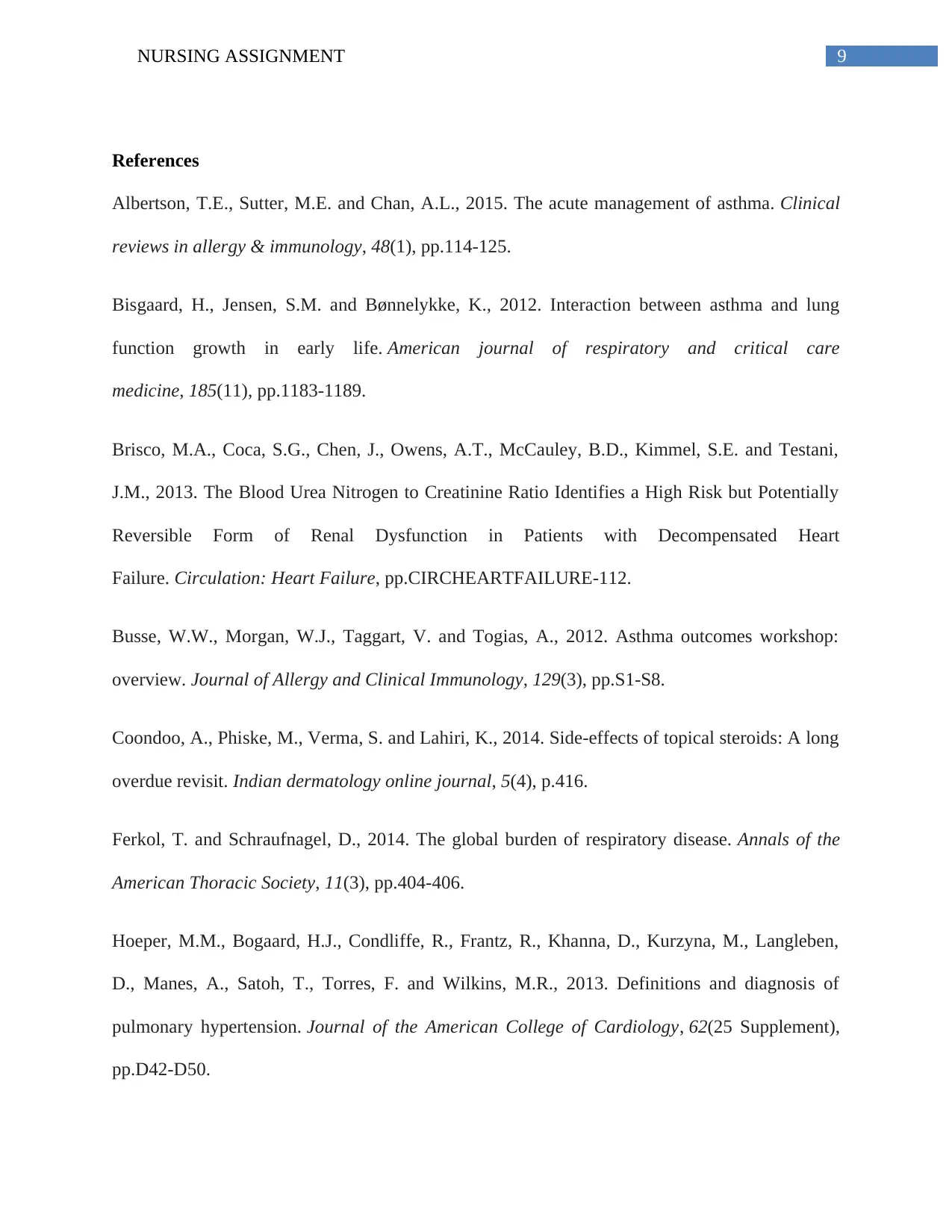
9NURSING ASSIGNMENT
References
Albertson, T.E., Sutter, M.E. and Chan, A.L., 2015. The acute management of asthma. Clinical
reviews in allergy & immunology, 48(1), pp.114-125.
Bisgaard, H., Jensen, S.M. and Bønnelykke, K., 2012. Interaction between asthma and lung
function growth in early life. American journal of respiratory and critical care
medicine, 185(11), pp.1183-1189.
Brisco, M.A., Coca, S.G., Chen, J., Owens, A.T., McCauley, B.D., Kimmel, S.E. and Testani,
J.M., 2013. The Blood Urea Nitrogen to Creatinine Ratio Identifies a High Risk but Potentially
Reversible Form of Renal Dysfunction in Patients with Decompensated Heart
Failure. Circulation: Heart Failure, pp.CIRCHEARTFAILURE-112.
Busse, W.W., Morgan, W.J., Taggart, V. and Togias, A., 2012. Asthma outcomes workshop:
overview. Journal of Allergy and Clinical Immunology, 129(3), pp.S1-S8.
Coondoo, A., Phiske, M., Verma, S. and Lahiri, K., 2014. Side-effects of topical steroids: A long
overdue revisit. Indian dermatology online journal, 5(4), p.416.
Ferkol, T. and Schraufnagel, D., 2014. The global burden of respiratory disease. Annals of the
American Thoracic Society, 11(3), pp.404-406.
Hoeper, M.M., Bogaard, H.J., Condliffe, R., Frantz, R., Khanna, D., Kurzyna, M., Langleben,
D., Manes, A., Satoh, T., Torres, F. and Wilkins, M.R., 2013. Definitions and diagnosis of
pulmonary hypertension. Journal of the American College of Cardiology, 62(25 Supplement),
pp.D42-D50.
References
Albertson, T.E., Sutter, M.E. and Chan, A.L., 2015. The acute management of asthma. Clinical
reviews in allergy & immunology, 48(1), pp.114-125.
Bisgaard, H., Jensen, S.M. and Bønnelykke, K., 2012. Interaction between asthma and lung
function growth in early life. American journal of respiratory and critical care
medicine, 185(11), pp.1183-1189.
Brisco, M.A., Coca, S.G., Chen, J., Owens, A.T., McCauley, B.D., Kimmel, S.E. and Testani,
J.M., 2013. The Blood Urea Nitrogen to Creatinine Ratio Identifies a High Risk but Potentially
Reversible Form of Renal Dysfunction in Patients with Decompensated Heart
Failure. Circulation: Heart Failure, pp.CIRCHEARTFAILURE-112.
Busse, W.W., Morgan, W.J., Taggart, V. and Togias, A., 2012. Asthma outcomes workshop:
overview. Journal of Allergy and Clinical Immunology, 129(3), pp.S1-S8.
Coondoo, A., Phiske, M., Verma, S. and Lahiri, K., 2014. Side-effects of topical steroids: A long
overdue revisit. Indian dermatology online journal, 5(4), p.416.
Ferkol, T. and Schraufnagel, D., 2014. The global burden of respiratory disease. Annals of the
American Thoracic Society, 11(3), pp.404-406.
Hoeper, M.M., Bogaard, H.J., Condliffe, R., Frantz, R., Khanna, D., Kurzyna, M., Langleben,
D., Manes, A., Satoh, T., Torres, F. and Wilkins, M.R., 2013. Definitions and diagnosis of
pulmonary hypertension. Journal of the American College of Cardiology, 62(25 Supplement),
pp.D42-D50.
Secure Best Marks with AI Grader
Need help grading? Try our AI Grader for instant feedback on your assignments.

10NURSING ASSIGNMENT
Ionescu, C.M., 2013. The human respiratory system. In The Human Respiratory System (pp. 13-
22). Springer London.
Korevaar, D.A., Westerhof, G.A., Wang, J., Cohen, J.F., Spijker, R., Sterk, P.J., Bel, E.H. and
Bossuyt, P.M., 2015. Diagnostic accuracy of minimally invasive markers for detection of airway
eosinophilia in asthma: a systematic review and meta-analysis. The Lancet Respiratory
Medicine, 3(4), pp.290-300.
Niimi, A., Ohbayashi, H., Sagara, H., Yamauchi, K., Akiyama, K., Takahashi, K., Inoue, H.,
Wakayama, T., Kobayashi, H., Hasegawa, M. and Kimura, G., 2013. Cough variant and cough-
predominant asthma are major causes of persistent cough: a multicenter study in Japan. Journal
of Asthma, 50(9), pp.932-937.
Papaiwannou, A., Zarogoulidis, P., Porpodis, K., Spyratos, D., Kioumis, I., Pitsiou, G., Pataka,
A., Tsakiridis, K., Arikas, S., Mpakas, A. and Tsiouda, T., 2014. Asthma-chronic obstructive
pulmonary disease overlap syndrome (ACOS): current literature review. Journal of thoracic
disease, 6(Suppl 1), p.S146.
Patel, M., Pilcher, J., Reddel, H.K., Pritchard, A., Corin, A., Helm, C., Tofield, C., Shaw, D.,
Black, P., Weatherall, M. and Beasley, R., 2013. Metrics of salbutamol use as predictors of
future adverse outcomes in asthma. Clinical & Experimental Allergy, 43(10), pp.1144-1151.
Pawankar, R., Canonica, G.W., Holgate, S.T. and Lockey, R.F., 2012. Allergic diseases and
asthma: a major global health concern. Current opinion in allergy and clinical
immunology, 12(1), pp.39-41.
Ionescu, C.M., 2013. The human respiratory system. In The Human Respiratory System (pp. 13-
22). Springer London.
Korevaar, D.A., Westerhof, G.A., Wang, J., Cohen, J.F., Spijker, R., Sterk, P.J., Bel, E.H. and
Bossuyt, P.M., 2015. Diagnostic accuracy of minimally invasive markers for detection of airway
eosinophilia in asthma: a systematic review and meta-analysis. The Lancet Respiratory
Medicine, 3(4), pp.290-300.
Niimi, A., Ohbayashi, H., Sagara, H., Yamauchi, K., Akiyama, K., Takahashi, K., Inoue, H.,
Wakayama, T., Kobayashi, H., Hasegawa, M. and Kimura, G., 2013. Cough variant and cough-
predominant asthma are major causes of persistent cough: a multicenter study in Japan. Journal
of Asthma, 50(9), pp.932-937.
Papaiwannou, A., Zarogoulidis, P., Porpodis, K., Spyratos, D., Kioumis, I., Pitsiou, G., Pataka,
A., Tsakiridis, K., Arikas, S., Mpakas, A. and Tsiouda, T., 2014. Asthma-chronic obstructive
pulmonary disease overlap syndrome (ACOS): current literature review. Journal of thoracic
disease, 6(Suppl 1), p.S146.
Patel, M., Pilcher, J., Reddel, H.K., Pritchard, A., Corin, A., Helm, C., Tofield, C., Shaw, D.,
Black, P., Weatherall, M. and Beasley, R., 2013. Metrics of salbutamol use as predictors of
future adverse outcomes in asthma. Clinical & Experimental Allergy, 43(10), pp.1144-1151.
Pawankar, R., Canonica, G.W., Holgate, S.T. and Lockey, R.F., 2012. Allergic diseases and
asthma: a major global health concern. Current opinion in allergy and clinical
immunology, 12(1), pp.39-41.

11NURSING ASSIGNMENT
Raimondi, G.A., Gonzalez, S., Zaltsman, J., Menga, G. and Adrogué, H.J., 2013. Acid–base
patterns in acute severe asthma. Journal of asthma, 50(10), pp.1062-1068.
Sahan, M., Yılmaz, M., Gokel, Y., Erden, E.S. and Karakus, A., 2013. Nebulized salbutamol for
asthma: Effects on serum potassium and phosphate levels at the 60min. Revista portuguesa de
pneumologia, 19(5), pp.200-203.
Sellers, W.F.S., 2012. Inhaled and intravenous treatment in acute severe and life-threatening
asthma. British journal of anaesthesia, 110(2), pp.183-190.
Short, P.M., Williamson, P.A. and Lipworth, B.J., 2012. Effects of hydrocortisone on acute β‐
adrenoceptor blocker and histamine induced bronchoconstriction. British journal of clinical
pharmacology, 73(5), pp.717-726.
Short, P.M., Williamson, P.A., Anderson, W.J. and Lipworth, B.J., 2013. Randomized placebo-
controlled trial to evaluate chronic dosing effects of propranolol in asthma. American journal of
respiratory and critical care medicine, 187(12), pp.1308-1314.
Skidmore-Roth, L., 2013. Mosby's 2014 nursing drug reference. Elsevier Health Sciences.
Torres, S., Sticco, N., Bosch, J.J., Iolster, T., Siaba, A., Rocca, R.M. and Schnitzler, E., 2012.
Effectiveness of magnesium sulfate as initial treatment of acute severe asthma in children,
conducted in a tertiary-level university hospital: a randomized, controlled trial. Archivos
argentinos de pediatria, 110(4), pp.291-296.
Vasquez, M.I., Lambrianides, A., Schneider, M., Kümmerer, K. and Fatta-Kassinos, D., 2014.
Environmental side effects of pharmaceutical cocktails: what we know and what we should
know. Journal of hazardous materials, 279, pp.169-189.
Raimondi, G.A., Gonzalez, S., Zaltsman, J., Menga, G. and Adrogué, H.J., 2013. Acid–base
patterns in acute severe asthma. Journal of asthma, 50(10), pp.1062-1068.
Sahan, M., Yılmaz, M., Gokel, Y., Erden, E.S. and Karakus, A., 2013. Nebulized salbutamol for
asthma: Effects on serum potassium and phosphate levels at the 60min. Revista portuguesa de
pneumologia, 19(5), pp.200-203.
Sellers, W.F.S., 2012. Inhaled and intravenous treatment in acute severe and life-threatening
asthma. British journal of anaesthesia, 110(2), pp.183-190.
Short, P.M., Williamson, P.A. and Lipworth, B.J., 2012. Effects of hydrocortisone on acute β‐
adrenoceptor blocker and histamine induced bronchoconstriction. British journal of clinical
pharmacology, 73(5), pp.717-726.
Short, P.M., Williamson, P.A., Anderson, W.J. and Lipworth, B.J., 2013. Randomized placebo-
controlled trial to evaluate chronic dosing effects of propranolol in asthma. American journal of
respiratory and critical care medicine, 187(12), pp.1308-1314.
Skidmore-Roth, L., 2013. Mosby's 2014 nursing drug reference. Elsevier Health Sciences.
Torres, S., Sticco, N., Bosch, J.J., Iolster, T., Siaba, A., Rocca, R.M. and Schnitzler, E., 2012.
Effectiveness of magnesium sulfate as initial treatment of acute severe asthma in children,
conducted in a tertiary-level university hospital: a randomized, controlled trial. Archivos
argentinos de pediatria, 110(4), pp.291-296.
Vasquez, M.I., Lambrianides, A., Schneider, M., Kümmerer, K. and Fatta-Kassinos, D., 2014.
Environmental side effects of pharmaceutical cocktails: what we know and what we should
know. Journal of hazardous materials, 279, pp.169-189.

12NURSING ASSIGNMENT
Vestbo, J., Hurd, S.S., Agustí, A.G., Jones, P.W., Vogelmeier, C., Anzueto, A., Barnes, P.J.,
Fabbri, L.M., Martinez, F.J., Nishimura, M. and Stockley, R.A., 2013. Global strategy for the
diagnosis, management, and prevention of chronic obstructive pulmonary disease: GOLD
executive summary. American journal of respiratory and critical care medicine, 187(4), pp.347-
365.
Vestbo, J., Hurd, S.S., Agustí, A.G., Jones, P.W., Vogelmeier, C., Anzueto, A., Barnes, P.J.,
Fabbri, L.M., Martinez, F.J., Nishimura, M. and Stockley, R.A., 2013. Global strategy for the
diagnosis, management, and prevention of chronic obstructive pulmonary disease: GOLD
executive summary. American journal of respiratory and critical care medicine, 187(4), pp.347-
365.
1 out of 13
Related Documents
Your All-in-One AI-Powered Toolkit for Academic Success.
+13062052269
info@desklib.com
Available 24*7 on WhatsApp / Email
![[object Object]](/_next/static/media/star-bottom.7253800d.svg)
Unlock your academic potential
© 2024 | Zucol Services PVT LTD | All rights reserved.





